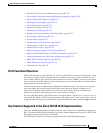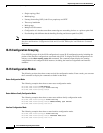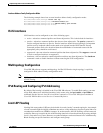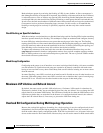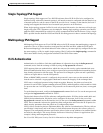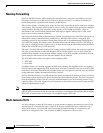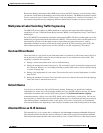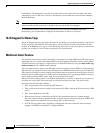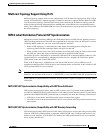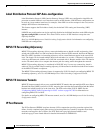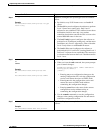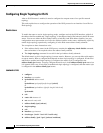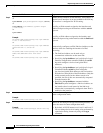
Implementing IS-IS on Cisco IOS XR Software
Information About Implementing IS-IS on Cisco IOS XR Software
RC-275
Cisco IOS XR Routing Configuration Guide
OL-14356-01
Multicast Topology Support Using IS-IS
Multicast topology support allows for the configuration of IS-IS multicast topologies for IPv4 or IPv6
routing. IS-IS maintains a separate topology for multicast and runs a separate Shortest Path First (SPF)
over the multicast topology. IS-IS multicast inserts routes from the IS-IS multicast topology into the
multicast-unicast Routing Information Base (muRIB) table in the RIB for the corresponding address
family. Since PIM uses the muRIB, PIM uses routes from the multicast topology instead of routes from
the unicast topology.
MPLS Label Distribution Protocol IGP Synchronization
Multiprotocol Label Switching (MPLS) Label Distribution Protocol (LDP) Interior Gateway Protocol
(IGP) Synchronization ensures that LDP has completed label exchange before the IGP path is used for
switching. MPLS traffic loss can occur in the following two situations:
• When an IGP adjacency is established, the router begins forwarding packets using the new
adjacency before LDP has exchanged labels with peers on that link.
• When an LDP session closes, the router continues to forward traffic using the link associated with
the LDP peer rather than using an alternate path with an established LDP session.
This feature provides a mechanism to synchronize LDP and IS-IS to minimize MPLS packet loss. The
synchronization is accomplished by changing the link metric for a neighbor IS-IS link-state packet
(LSP), based on the state of the LDP session.
When an IS-IS adjacency is established on a link but the LDP session is lost or LDP has not yet
completed exchanging labels, IS-IS advertises the maximum metric on that link. In this instance, LDP
IS-IS synchronization is not yet achieved.
Note In IS-IS, a link with a maximum wide metric (0xFFFFFF) is not considered for shortest path first (SPF).
Therefore, the maximum wide metric of -1 (0XFFFFFE) is used with MPLS LDP IGP synchronization.
When LDP IS-IS synchronization is achieved, IS-IS advertises a regular (configured or default) metric
on that link.
MPLS LDP-IGP Synchronization Compatibility with LDP Graceful Restart
LDP graceful restart protects traffic when an LDP session is lost. If a graceful restart-enabled LDP
session fails, MPLS LDP IS-IS synchronization is still achieved on the interface while it is protected by
graceful restart. MPLS LDP IGP synchronization is eventually lost under the following circumstances:
• LDP fails to restart before the LDP graceful restart reconnect timer expires.
• The LDP session on the protected interface fails to recover before the LDP graceful restart recovery
timer expires.
MPLS LDP-IGP Synchronization Compatibility with IGP Nonstop Forwarding
IS-IS nonstop forwarding (NSF) protects traffic during IS-IS process restarts and route processor (RP)
failovers. LDP IS-IS synchronization is supported with IS-IS NSF only if LDP graceful restart is also
enabled over the interface. If IS-IS NSF is not enabled, the LDP synchronization state is not retained
across restarts and failovers.



